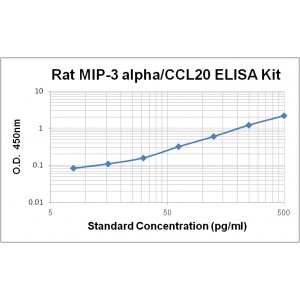More info
Assay Range | 7.8 - 500 pg/mL |
Sensitivity | 10.0 pg/mL |
Size | 96T |
Storage | Store at 2 - 8ºC. Keep reconstituted standard and detection Ab at -20 ºC |
Assay Principle | Sandwich ELISA |
Sample Volume | 100 µL final volume, dilution factor varies on samples |
Detection Method | Chromogenic |
Kit Components
1. Recombinant Rat MIP-3 alpha standard: 2 vials
2. One 96-well plate coated with Rat MIP-3 alpha Ab
3. Sample diluent buffer: 12 mL - 1
4. Detection antibody: 130 µL, dilution 1:100
5. Streptavidin-HRP: 130 µL, dilution 1:100
6. Antibody diluent buffer: 12 mL x1
7. Streptavidin-HRP diluent buffer: 12 mL x1
8. TMB developing agent: 10 mL x1
9. Stop solution: 10 mL x1
10. Washing solution (20x): 25 mL x1
Background
MIP-3α, also known as liver and activation-regulated chemokine (LARC), Exodus-1 or CCL20, is a member of the CC chemokine family. The full-length MIP-3α is a 96 amino acids (aa) protein containing four conserved cysteine residues among CC chemokines. It shares the highest aa sequence homology with MIP-1β. Rat MIP-3α cDNA encodes a 96 amino acid (aa) precursor protein composed of a 25 aa putative signal peptide and a 71 aa mature secreted protein. Rat MIP3α exhibits approximately 70 and 61% aa sequence identity with mouse and human MIP-3α, respectively. MIP-3α is produced by various activated cells, including monocytes, T cells, endothelial cells, epithelial cells, and fibroblasts. Expression of the MIP-3α is inducible in response to activation of TNF-α, IL-1β, CD40, IFN-γ, and IL-17.
MIP-3α is a ligand for the G protein-coupled chemokine receptor CCR6. Expression of CCR6 is affected by a variety of cytokines, such as TGF-β1, TNF-α and IL-4. MIP-3α plays an important role in the regulation of DC trafficking, and recruitment and activation of T cells. Expression of MIP-3α and CCR6 is significantly up-regulated in psoriasis, suggesting that the interaction between MIP-3α and its receptor is important for T cell recruitment to lesional psoriatic skin.


